Critical measures include intensive systems, disease-free seedstock, pathogen-free water and strong biosecurity
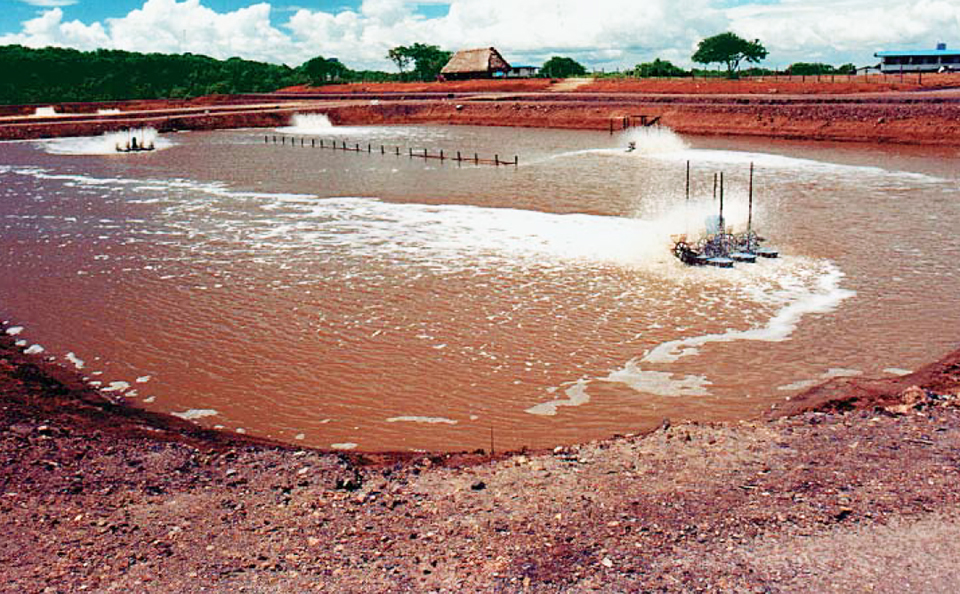
The shrimp farming industry in Panama, which relies mostly on semi-intensive technology that is highly vulnerable to several shrimp pathogens, has been severely affected by WSSV since March 1999. A different approach using a zero-exchange, intensive system was designed, built, and operated for one cycle to determine the feasibility of producing shrimp commercially in areas of Panama where WSSV is widespread. The final design of this project relied significantly on earlier work on zero-exchange systems at the Waddell Mariculture Center (South Carolina, USA), Belize Aquaculture, Ltd., and on preliminary work carried out at the Camaco farm in Panama.
Farm description
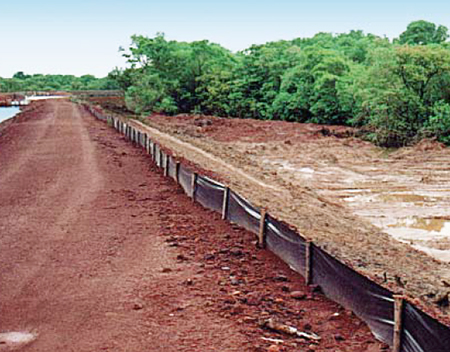
The farm is located on the Azuero Peninsula about three hours from Panama City. Construction of the first phase, carried out during early 2000, included support facilities (warehouse, laboratory, and office), a pump station and screen filtration system, three 1-hectare reservoirs connected in series, a 3-ha sedimentation pond, and 20 production ponds with a depth of 1.2 to 1.4 meters and area of 4,000 square meters each. The farm draws water from a tidal creek about 1 km from its mouth to the ocean. Each pond is equipped with four, 2-hp paddle wheel aerators (20 horsepower per hectare).
Pond preparation and stocking
Pond preparation procedures included the application of five metric tons (MT) of calcium carbonate per pond (equivalent to 12.5 MT per hectare). Water was filtered at the entrance to the first reservoir through 1,000-micron mesh, through 500 micron between reservoirs, and between the last reservoir and the distribution canal.
Ponds were filled through two 15-cm PVC pipes fitted with 250-micron filter bags on the canal side and 100-micron filter bags on the inside of the pond. It took two days to fill up a pond, and about two weeks to have all ponds at the operational depth.
Five days after pond filling, the insecticide Neguvon (1 ppm) was applied to the pond water. After 10 days, a postlarvae survival test was carried out with water sampled from ponds to assure there was no residual effect. Inorganic fertilization was carried out with urea (30 kilograms per hectare) and TSP (5 kilograms per hectare).
Seedstock
Postlarvae produced from specific pathogen free broodstock and reared at the Camaco Laboratory were used to stock the ponds. Broodstock originated from Shrimp Improvement Systems (Florida, USA) and had been certified free of WSSV and IHHN. PL13-17 were directly stocked after a short, pond-side acclimation. Three stocking densities were used (50, 60 and 80 PL per square meter).
Pond management during cycle
Aeration
One of the main objectives was to maintain minimum DO levels at no less than 5 milligrams per liter for the duration of the cycle. During the first two weeks after stocking, no aeration was needed to maintain acceptable DO levels. Between days 16 and 30, only two aerators were operated for 8 hours during the night. Between days 31 and 60, all four aerators were needed, running for 12 h during night. Between days 61 and 75, the aerators operated for 18 hours (4 p.m. to 10 a.m.). After day 75, they ran around the clock.
Feeding
A local feed (25 percent protein) was used during the entire cycle, and manually distributed from the pond levees. During the first month after stocking, feeding rates were based on a table, and applied twice per day. Starting around week 5, daily rations were adjusted using two feed trays per pond. Three feed applications were used between days 30 and 70, and increased to five applications thereafter.
Results
Survival rates obtained were excellent when compared to typical rates for the rest of the country, averaging 80 percent and ranging from 52 to 95 percent (Table 1) after an average of 120 days (range 112 to 129 days). Growth rates averaged 0.70 grams per week (range 0.61 to 0.82 grams per week). The mean production for the 20 ponds was 4,941 kilograms per hectare (range 3,515 to 7,555 kilograms per hectare), and a total of 39,530 kg of shrimp were harvested in this first cycle of operation (Fig. 1).
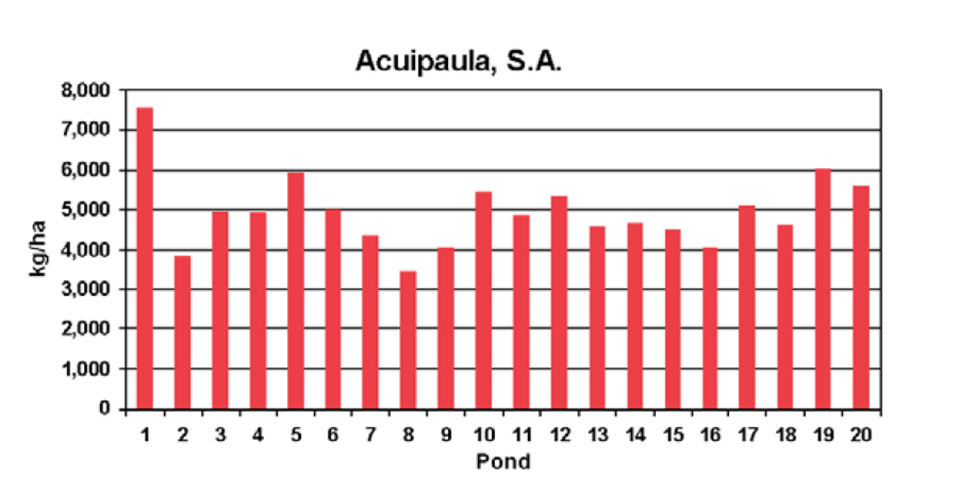
Grillo, Summary of production results, Table 1
| Parameter | Value |
|---|
Parameter | Value |
|---|---|
| Cycle Duration (Days) | 112-127 (118) |
| Survival Rates (%) | 58-91 (74) |
| kg/Pond | 1,406-3,022 (2,014) |
| kg/ha | 3,515-7,555 (4,941) |
| Mean Weight at Harvest (g) | 11.1-14.0 (12.6) |
| Growth (g/Week) | 0.68-0.82 (0.74) |
| FCR | 1.6-2.1 (2.0) |
Production reflected the stocking densities, with ponds stocked at 50 PL per m2 averaging 4,736 kilograms per hectare. At 60 PL per m2, the ponds averaged 6,028 kilograms per hectare, and at 80 PL per m2 averaged 7,555 kilograms per hectare. Fig. 2 compares shrimp production (headson) per hectacre and feed conversion rates (FCR) at different stocking densities.
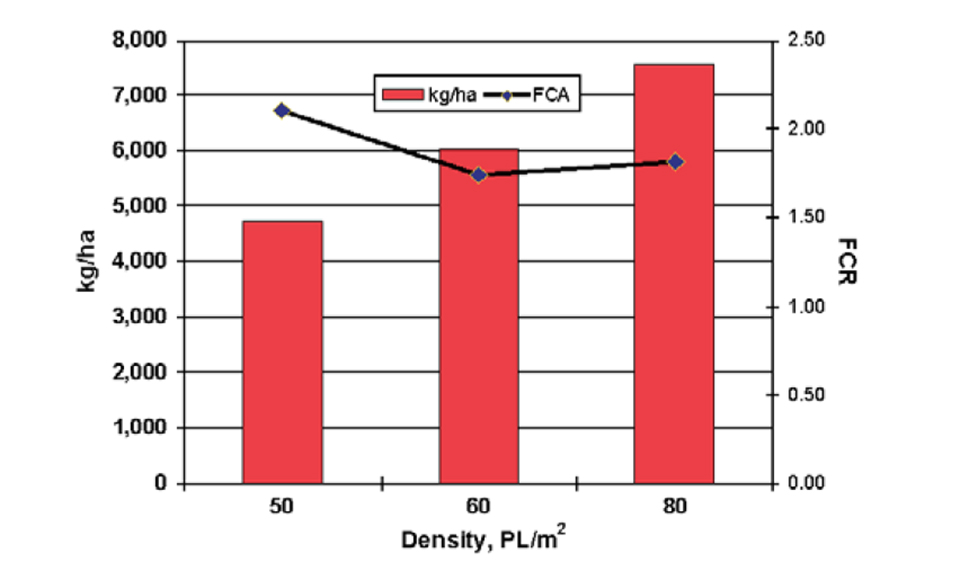
The main objectives of this first production cycle were accomplished, namely to maximize biosecurity by excluding pathogens and their vectors (particularly WSSV), and to maintain pond conditions as optimal as possible. Although the FCR values can undoubtedly be improved, no diseases were observed and the economic results were very positive. The production costs were U.S. $2.49 per kilogram at 80 PL per square meter, $3.10 per kilogram at 60 PL per square meter, and $3.96 per kilogram at 50 PL per square meter.
Conclusion
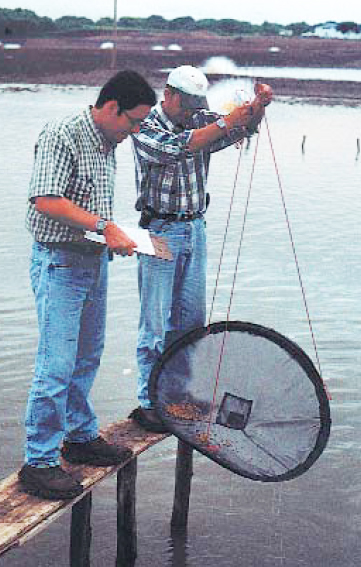
The results obtained demonstrated it is possible to grow shrimp commercially in areas of Panama where WSSV is endemic, using biosecure, intensive systems with zero exchange of pond water. The critical elements of this system – as reported by others before – are the use of healthy, disease- free seedstock; water free of pathogens and other biosecurity measures; and no exchange of water during the cycle.
(Editor’s Note: This article was originally published in the December 2000 print edition of the Global Aquaculture Advocate.)
Now that you've finished reading the article ...
… we hope you’ll consider supporting our mission to document the evolution of the global aquaculture industry and share our vast network of contributors’ expansive knowledge every week.
By becoming a Global Seafood Alliance member, you’re ensuring that all of the pre-competitive work we do through member benefits, resources and events can continue. Individual membership costs just $50 a year. GSA individual and corporate members receive complimentary access to a series of GOAL virtual events beginning in April. Join now.
Not a GSA member? Join us.
Authors
-
-
Durwood M. Dugger
BioCepts International, Inc.
Ft. Pierce, Florida, USA
www.biocepts.com -

Related Posts

Responsibility
Advances in super-intensive, zero-exchange shrimp raceways
Research at the Texas AgriLife Research Mariculture Laboratory is investigating ways to improve the economic viability of super-intensive raceways for shrimp production.

Health & Welfare
Nursery performance of Pacific white shrimp in zero-exchange biofloc systems
The authors conducted studies to test the performance of young shrimp postlarvae in systems with different approaches to aeration and water handling. Proactive management through proper feed applications and water quality control were critical elements.

Responsibility
Biofilter start-up problems? Just add sugar!
One way to jump start biofilter operation is by adding sugar, which can provide sufficient organic carbon to neutralize the ammonia-nitrogen produced.

Health & Welfare
Biofloc technology holds potential for carnivorous fish species
Juvenile carnivorous African catfish performed well in biofloc-based systems, which could help produce better quality and more disease-resistant seed of this important aquaculture species and support the expansion of African catfish farming industry.


